Microstructure-Thermal Property Relationships of Poly (Ethylene Glycol- b-Caprolactone) Copolymers and Their Micelles
- PMID: 36297943
- PMCID: PMC9607102
- DOI: 10.3390/polym14204365
Microstructure-Thermal Property Relationships of Poly (Ethylene Glycol- b-Caprolactone) Copolymers and Their Micelles
Abstract
The crystallinity of polymers strongly affects their properties. For block copolymers, whereby two crystallisable blocks are covalently tethered to one another, the molecular weight of the individual blocks and their relative weight fraction are important structural parameters that control their crystallisation. In the case of block copolymer micelles, these parameters can influence the crystallinity of the core, which has implications for drug encapsulation and release. Therefore, in this study, we aimed to determine how the microstructure of poly(ethylene glycol-b-caprolactone) (PEG-b-PCL) copolymers contributes to the crystallinity of their hydrophobic PCL micelle cores. Using a library of PEG-b-PCL copolymers with PEG number-average molecular weight (Mn) values of 2, 5, and 10 kDa and weight fractions of PCL (fPCL) ranging from 0.11 to 0.67, the thermal behaviour and morphology were studied in blends, bulk, and micelles using differential scanning calorimetry (DSC), wide-angle X-ray diffraction (WXRD), and Synchrotron wide-angle X-ray scattering (WAXS). Compared to PEG and PCL homopolymers, the block copolymers displayed reduced crystallinity in the bulk phase and the individual blocks had a large influence on the crystallisation of one another. The fPCL was determined to be the dominant contributor to the extent and order of crystallisation of the two blocks. When fPCL < 0.35, the initial crystallisation of PEG led to an amorphous PCL phase. At fPCL values between 0.35 and 0.65, PEG crystallisation was followed by PCL crystallisation, whereas this behaviour was reversed when fPCL > 0.65. For lyophilised PEG-b-PCL micelles, the crystallinity of the core increased with increasing fPCL, although the core was predominately amorphous for micelles with fPCL < 0.35. These findings contribute to understanding the relationships between copolymer microstructure and micelle core crystallinity that are important for the design and performance of micellar drug delivery systems, and the broader application of polymer micelles.
Keywords: copolymer; crystallinity; micelle; microstructure; thermal behaviour.
Conflict of interest statement
The authors declare no conflict of interest.
Figures

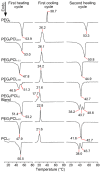
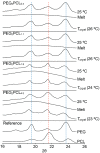

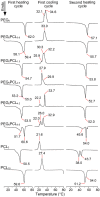
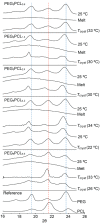

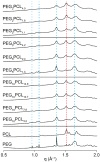
Similar articles
-
Interrogating the relationship between the microstructure of amphiphilic poly(ethylene glycol-b-caprolactone) copolymers and their colloidal assemblies using non-interfering techniques.J Colloid Interface Sci. 2022 Jan 15;606(Pt 2):1140-1152. doi: 10.1016/j.jcis.2021.08.084. Epub 2021 Aug 17. J Colloid Interface Sci. 2022. PMID: 34492457 Free PMC article.
-
Fine tuning micellar core-forming block of poly(ethylene glycol)-block-poly(ε-caprolactone) amphiphilic copolymers based on chemical modification for the solubilization and delivery of doxorubicin.Biomacromolecules. 2011 Jul 11;12(7):2562-72. doi: 10.1021/bm200375x. Epub 2011 Jun 6. Biomacromolecules. 2011. PMID: 21598958
-
Influence of Lyophilization and Cryoprotection on the Stability and Morphology of Drug-Loaded Poly(ethylene glycol-b-ε-caprolactone) Micelles.Polymers (Basel). 2023 Apr 21;15(8):1974. doi: 10.3390/polym15081974. Polymers (Basel). 2023. PMID: 37112121 Free PMC article.
-
Stabilization of poly(ethylene glycol)-poly(ε-caprolactone) star block copolymer micelles via aromatic groups for improved drug delivery properties.J Colloid Interface Sci. 2018 Mar 15;514:468-478. doi: 10.1016/j.jcis.2017.12.057. Epub 2017 Dec 20. J Colloid Interface Sci. 2018. PMID: 29289031
-
Amphiphilic toothbrushlike copolymers based on poly(ethylene glycol) and poly(epsilon-caprolactone) as drug carriers with enhanced properties.Biomacromolecules. 2010 May 10;11(5):1331-8. doi: 10.1021/bm100116g. Biomacromolecules. 2010. PMID: 20405912
Cited by
-
Electrical and Mechanical Characterisation of Poly(ethylene)oxide-Polysulfone Blend for Composite Structural Lithium Batteries.Polymers (Basel). 2023 Jun 5;15(11):2581. doi: 10.3390/polym15112581. Polymers (Basel). 2023. PMID: 37299379 Free PMC article.
-
Synthesis and Characterization of Ciprofloxacin Loaded Star-Shaped Polycaprolactone-Polyethylene Glycol Hydrogels for Oral Delivery.Micromachines (Basel). 2023 Jul 6;14(7):1382. doi: 10.3390/mi14071382. Micromachines (Basel). 2023. PMID: 37512693 Free PMC article.
References
-
- Allen C., Maysinger D., Eisenberg A. Nano-engineering block copolymer aggregates for drug delivery. Colloids Surf. B Biointerfaces. 1999;16:3–27. doi: 10.1016/S0927-7765(99)00058-2. - DOI
-
- Glavas L., Odelius K., Albertsson A.-C. Tuning loading and release by modification of micelle core crystallinity and preparation. Polym. Adv. Technol. 2015;26:880–888. doi: 10.1002/pat.3524. - DOI
-
- Sevgen E.S., de Pablo J.J., Hubbell J.A. A computational and experimental study of crystallization-driven self-assembly and micelle formation in poly (ethylene glycol)-b-oligo (ethylene sulfide) Biophys. J. 2018;114:528a. doi: 10.1016/j.bpj.2017.11.2886. - DOI
Grants and funding
LinkOut - more resources
Full Text Sources

